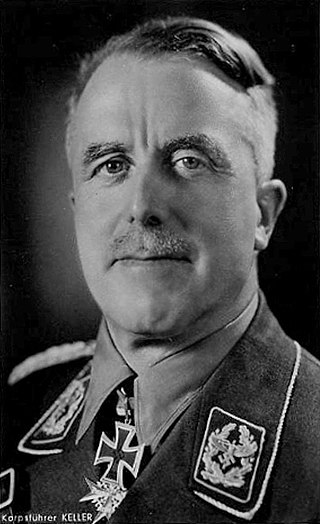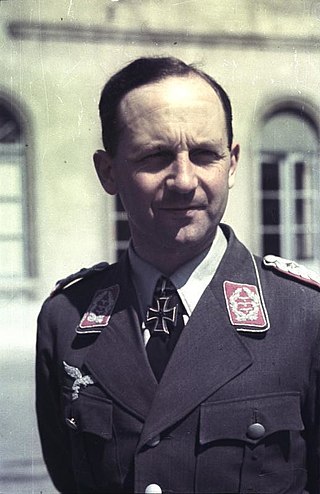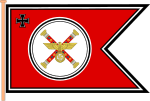
The flag of Nazi Germany, officially the flag of the German Reich, featured a red background with a black swastika on a white disc. This flag came into use initially as the banner of the Nazi Party (NSDAP) after its foundation. Following the appointment of Adolf Hitler as Chancellor in 1933, this flag was adopted as one of the nation's dual national flags, the other being the black-white-red triband of the German Empire.

The term Reichskriegsflagge refers to several war flags and war ensigns used by the German armed forces in history. A total of eight different designs were used in 1848–1849 and between 1867–1871 and 1945.

Alfred Schwarzmann was a German Olympic gymnast. He won three gold and two bronze medals at the 1936 Berlin Olympics and another silver medal at the 1952 Summer Olympics. During World War II, Schwarzmann served in the Wehrmacht and was a recipient of the Knight's Cross of the Iron Cross of Nazi Germany.

Alfred Keller was a general in the Luftwaffe of Nazi Germany during the Second World War who commanded the Luftflotte 1. His career in the Imperial German Armed Forces began in 1897; he served as a bomber pilot in World War I.

Karl Hubert Lanz was a German general during the Second World War, in which he led units in the Eastern Front and in the Balkans. After the war, he was tried for war crimes and convicted in the Southeast Case, specifically for several atrocities committed by units under his command in the Balkans. Released in 1951, he joined the liberal Free Democratic Party and served as its adviser on military and security issues.
The Balkenkreuz is a straight-armed cross that was first introduced in 1916–1918 and later became the emblem of the Wehrmacht and its branches from 1935 until the end of World War II. It was used by the Wehrmacht Heer (Army), Luftwaffe, and Kriegsmarine (Navy).

The Wehrmacht were the unified armed forces of Nazi Germany from 1935 to 1945. It consisted of the Heer (army), the Kriegsmarine (navy) and the Luftwaffe. The designation "Wehrmacht" replaced the previously used term Reichswehr and was the manifestation of the Nazi regime's efforts to rearm Germany to a greater extent than the Treaty of Versailles permitted.

Hans Georg Heer is a German historian, chiefly known for the Wehrmachtsausstellung in the 1990s. While controversial at that time, the exhibition is nowadays widely credited with opening the eyes of the German public to the war crimes of the Wehrmacht committed on the Eastern Front during World War II. Having been suspended in 1999 for review, the exhibit reopened in 2001 under the name "Crimes of the German Wehrmacht: Dimensions of a War of Annihilation 1941–1944". The exhibitions were instrumental in the debunking of the myth of the clean Wehrmacht in Germany.
The 19th Infantry Division was a formation of the German Wehrmacht during World War II.
Generaloberstabsarzt and Admiraloberstabsarzt are the top Joint Medical Service OF8-ranks of the German Bundeswehr. The equivalent to this ranks in the Heer is Generalleutnant and in the German Navy the Vizeadmiral.
Corps colours, or Troop-function colours were worn in the German Army (Heer) from 1935 until 1945 in order to distinguish between several branches, special services, corps, rank groups, and appointments of the ministerial area, the general staff, and the Oberkommando der Wehrmacht (OKW). The corps colours were part of the pipings, gorget patches, shoulder straps, as well as part of the arabesque and lampasse of any general officer and flag officer. It was also part of heraldic flags, colours, standards, and guidons.

Corps colours, or troop-function colours were worn in the German Luftwaffe from 1935 until 1945, in order to distinguish between several branches, special services, corps, rank groups, and appointments of the ministerial area, the general staff, and the Oberkommando der Wehrmacht (OKW). The corps colours were part of the uniform piping, gorget patches, shoulder straps, arabesque and lampasse ornaments of general and flag officers. They were also part of heraldic flags, colours, standards, and guidons.
This page is based on this
Wikipedia article Text is available under the
CC BY-SA 4.0 license; additional terms may apply.
Images, videos and audio are available under their respective licenses.


























